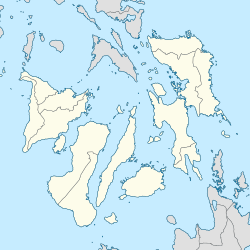|
Old Oton Church
The old Oton Church, also known as the Immaculate Conception Parish Church, was a Gothic - Neoclassical Roman Catholic church located in Oton, Iloilo, Philippines. Once one of the largest churches in the country, it was destroyed in an earthquake in 1948.[1] HistoryThe town of Ogtong (now known as Oton) was founded in 1566 by the Spaniards, becoming the second Spanish settlement in the Philippines, after Cebu. The first chapel was built in the same year following the Spanish establishment of Oton. In 1572, the Augustinian friars, led by Friar Martin de Rada, arrived in Oton from Dumangas, where they had successfully evangelized the local population. They founded their chapter house in Oton on May 3, 1572, making it the third such establishment after Cebu and Manila. That same year, the church dedicated to Our Lady of the Immaculate Conception was declared a parish. The initial church in Oton was destroyed on September 29, 1614, during an attack by Dutch privateers led by Georges Spillberg. The town faced additional attacks from British forces in 1593, the Dutch in 1630, and Moro raiders in 1662. Despite these challenges, the Augustinians maintained their mission in Oton. The Spanish-era colonial church was constructed under Friar Demetrio Cobos between 1845 and 1853. Construction continued and was completed by Friar Joaquin Fernandez in 1882, with interior decorations credited to Friar Nicolas Gallo between 1889 and 1890. The church was officially consecrated in 1891.[2] 1948 Lady Caycay earthquakeOn January 24, 1948, the Lady Caycay Earthquake, with an estimated magnitude of 7.8, struck the Philippines, causing extensive damage. The church was severely damaged and reduced to rubble. In the aftermath, the church was demolished to make way for the present-day Immaculate Conception Church. The construction of the new church, initiated by Fr. Ernesto L. Calvo, the first Filipino parish priest in Oton, took two decades to complete. The new church was blessed on Christmas Day, December 25, 1972, and a marker commemorating its consecration was installed by the main entrance by Fr. Renato Elmido in 1988. Only two bells and some stone remnants of the old church survived the disaster.[3] ArchitectureThe church was once among the largest churches in the Philippines. It was notable for its combination of Greek, Byzantine, and Gothic-Classical architectural elements. The church was designed in the shape of a Greek cross, with all four arms of equal length. Each side of the cross featured two towers, totaling six towers for the entire church. At the center of the church is a large altar or retablo mayor, a distinctive feature not commonly found in Philippine churches. The church's dome rises to a height of 68.28 metres (224.0 ft).[4] Gallery
References
External links
|
||||||||||||||||||||||||||||||||||||||||||||||||||||||||






